2012 FORD F650 automatic transmission
[x] Cancel search: automatic transmissionPage 134 of 306
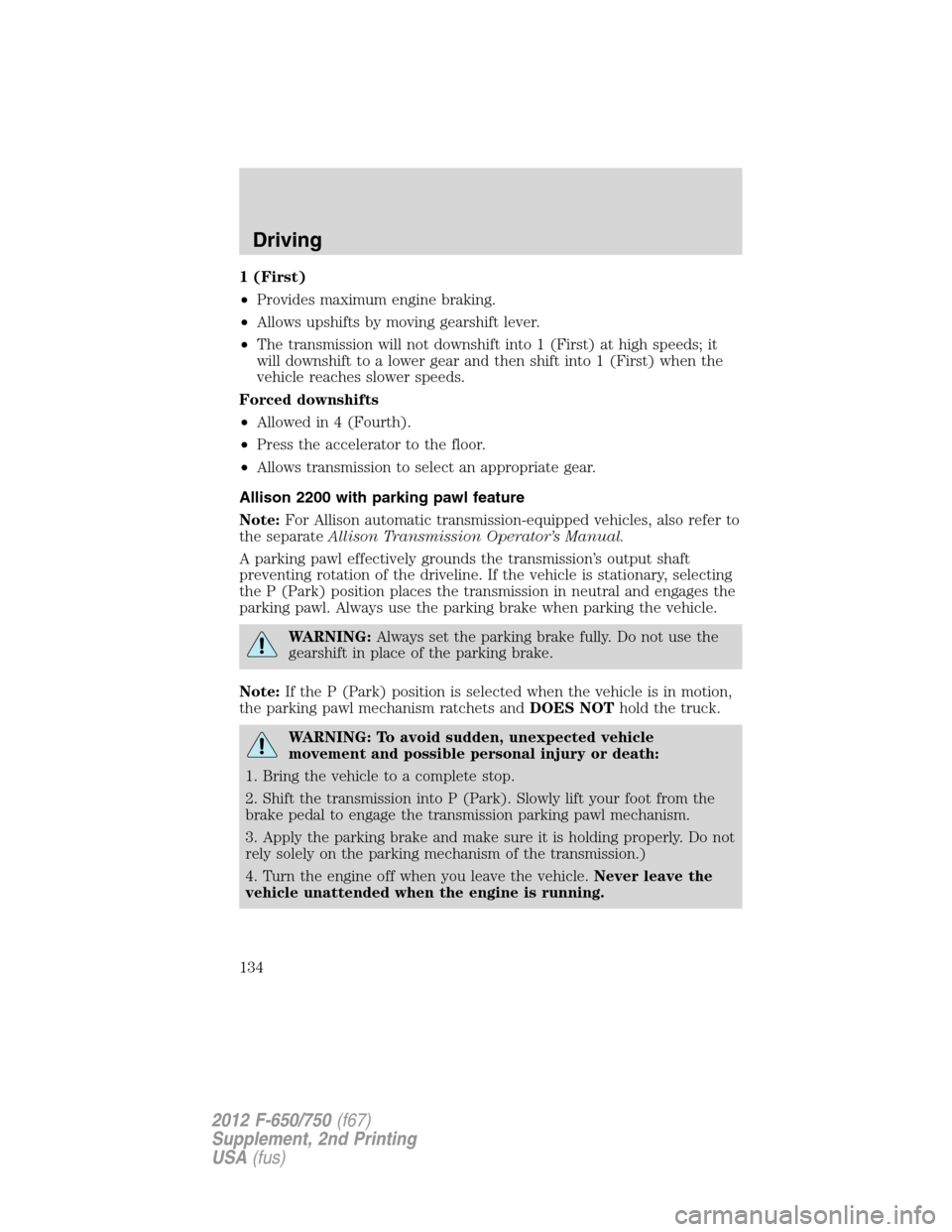
1 (First)
•Provides maximum engine braking.
•Allows upshifts by moving gearshift lever.
•The transmission will not downshift into 1 (First) at high speeds; it
will downshift to a lower gear and then shift into 1 (First) when the
vehicle reaches slower speeds.
Forced downshifts
•Allowed in 4 (Fourth).
•Press the accelerator to the floor.
•Allows transmission to select an appropriate gear.
Allison 2200 with parking pawl feature
Note:For Allison automatic transmission-equipped vehicles, also refer to
the separateAllison Transmission Operator’s Manual.
A parking pawl effectively grounds the transmission’s output shaft
preventing rotation of the driveline. If the vehicle is stationary, selecting
the P (Park) position places the transmission in neutral and engages the
parking pawl. Always use the parking brake when parking the vehicle.
WARNING:Always set the parking brake fully. Do not use the
gearshift in place of the parking brake.
Note:If the P (Park) position is selected when the vehicle is in motion,
the parking pawl mechanism ratchets andDOES NOThold the truck.
WARNING: To avoid sudden, unexpected vehicle
movement and possible personal injury or death:
1. Bring the vehicle to a complete stop.
2. Shift the transmission into P (Park). Slowly lift your foot from the
brake pedal to engage the transmission parking pawl mechanism.
3. Apply the parking brake and make sure it is holding properly. Do not
rely solely on the parking mechanism of the transmission.)
4. Turn the engine off when you leave the vehicle.Never leave the
vehicle unattended when the engine is running.
Driving
134
2012 F-650/750(f67)
Supplement, 2nd Printing
USA(fus)
Page 140 of 306
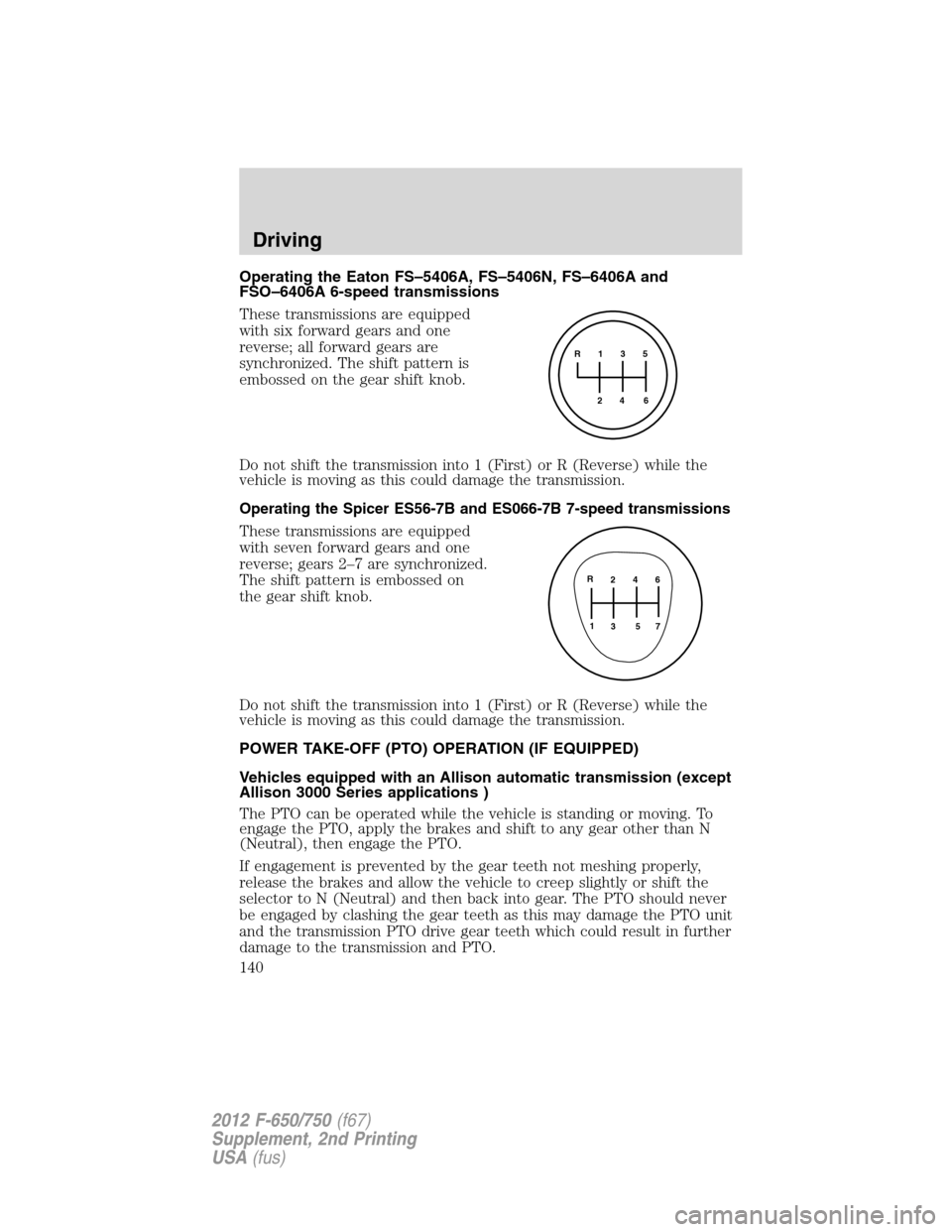
Operating the Eaton FS–5406A, FS–5406N, FS–6406A and
FSO–6406A 6-speed transmissions
These transmissions are equipped
with six forward gears and one
reverse; all forward gears are
synchronized. The shift pattern is
embossed on the gear shift knob.
Do not shift the transmission into 1 (First) or R (Reverse) while the
vehicle is moving as this could damage the transmission.
Operating the Spicer ES56-7B and ES066-7B 7-speed transmissions
These transmissions are equipped
with seven forward gears and one
reverse; gears 2–7 are synchronized.
The shift pattern is embossed on
the gear shift knob.
Do not shift the transmission into 1 (First) or R (Reverse) while the
vehicle is moving as this could damage the transmission.
POWER TAKE-OFF (PTO) OPERATION (IF EQUIPPED)
Vehicles equipped with an Allison automatic transmission (except
Allison 3000 Series applications )
The PTO can be operated while the vehicle is standing or moving. To
engage the PTO, apply the brakes and shift to any gear other than N
(Neutral), then engage the PTO.
If engagement is prevented by the gear teeth not meshing properly,
release the brakes and allow the vehicle to creep slightly or shift the
selector to N (Neutral) and then back into gear. The PTO should never
be engaged by clashing the gear teeth as this may damage the PTO unit
and the transmission PTO drive gear teeth which could result in further
damage to the transmission and PTO.
R 1 3 5
4
6 2
2 4 6
3 5 71 R
Driving
140
2012 F-650/750(f67)
Supplement, 2nd Printing
USA(fus)
Page 141 of 306
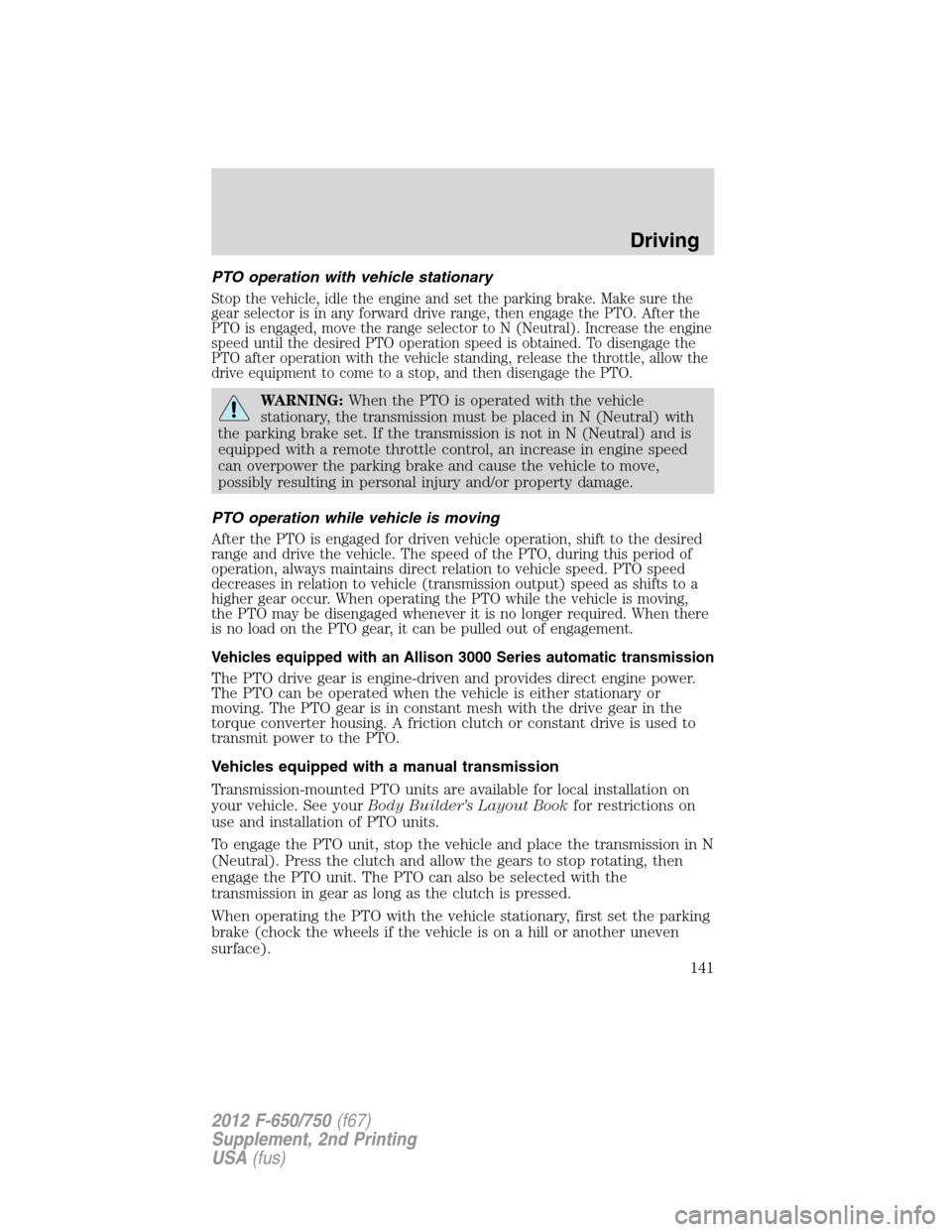
PTO operation with vehicle stationary
Stop the vehicle, idle the engine and set the parking brake. Make sure the
gear selector is in any forward drive range, then engage the PTO. After the
PTO is engaged, move the range selector to N (Neutral). Increase the engine
speed until the desired PTO operation speed is obtained. To disengage the
PTO after operation with the vehicle standing, release the throttle, allow the
drive equipment to come to a stop, and then disengage the PTO.
WARNING:When the PTO is operated with the vehicle
stationary, the transmission must be placed in N (Neutral) with
the parking brake set. If the transmission is not in N (Neutral) and is
equipped with a remote throttle control, an increase in engine speed
can overpower the parking brake and cause the vehicle to move,
possibly resulting in personal injury and/or property damage.
PTO operation while vehicle is moving
After the PTO is engaged for driven vehicle operation, shift to the desired
range and drive the vehicle. The speed of the PTO, during this period of
operation, always maintains direct relation to vehicle speed. PTO speed
decreases in relation to vehicle (transmission output) speed as shifts to a
higher gear occur. When operating the PTO while the vehicle is moving,
the PTO may be disengaged whenever it is no longer required. When there
is no load on the PTO gear, it can be pulled out of engagement.
Vehicles equipped with an Allison 3000 Series automatic transmission
The PTO drive gear is engine-driven and provides direct engine power.
The PTO can be operated when the vehicle is either stationary or
moving. The PTO gear is in constant mesh with the drive gear in the
torque converter housing. A friction clutch or constant drive is used to
transmit power to the PTO.
Vehicles equipped with a manual transmission
Transmission-mounted PTO units are available for local installation on
your vehicle. See yourBody Builder’s Layout Bookfor restrictions on
use and installation of PTO units.
To engage the PTO unit, stop the vehicle and place the transmission in N
(Neutral). Press the clutch and allow the gears to stop rotating, then
engage the PTO unit. The PTO can also be selected with the
transmission in gear as long as the clutch is pressed.
When operating the PTO with the vehicle stationary, first set the parking
brake (chock the wheels if the vehicle is on a hill or another uneven
surface).
Driving
141
2012 F-650/750(f67)
Supplement, 2nd Printing
USA(fus)
Page 144 of 306
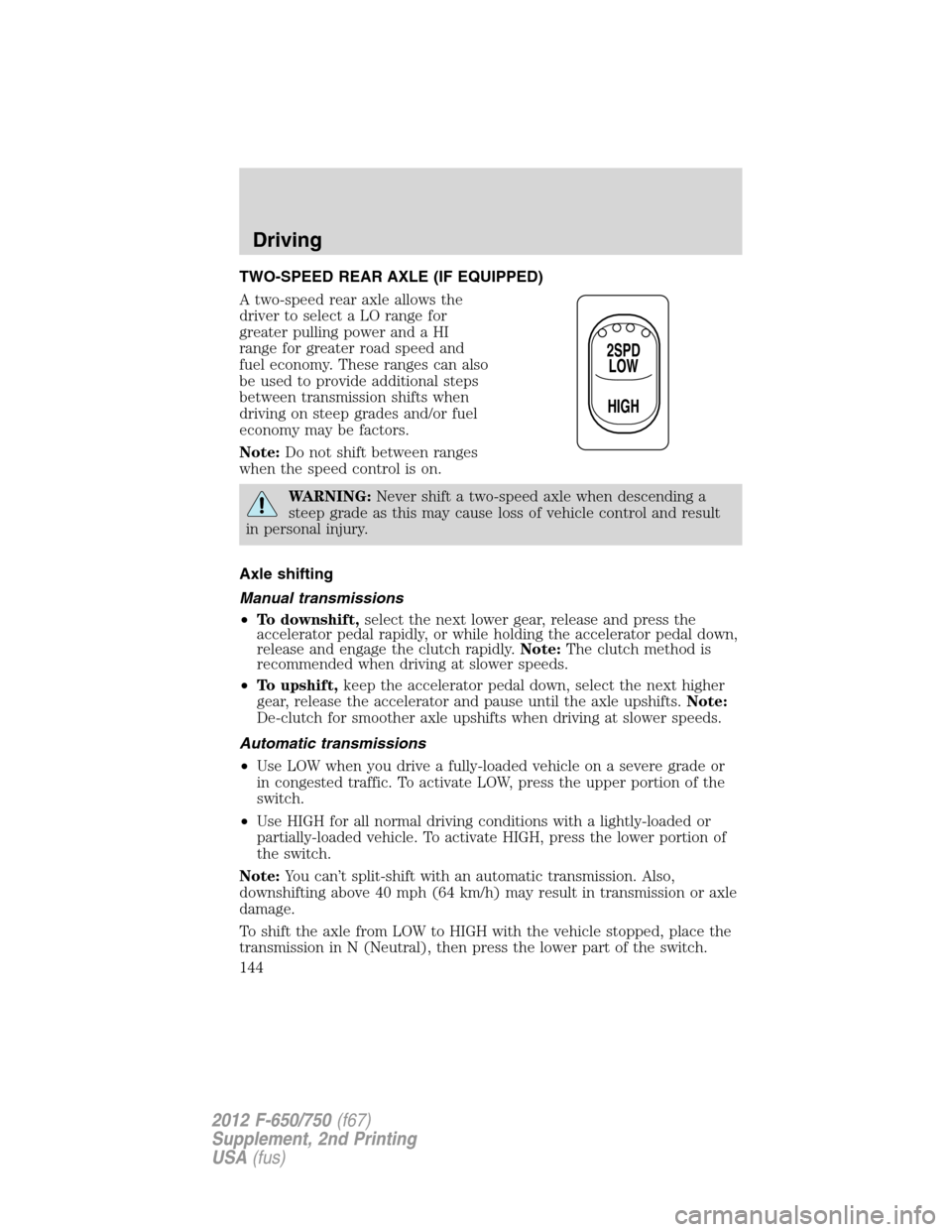
TWO-SPEED REAR AXLE (IF EQUIPPED)
A two-speed rear axle allows the
driver to select a LO range for
greater pulling power and a HI
range for greater road speed and
fuel economy. These ranges can also
be used to provide additional steps
between transmission shifts when
driving on steep grades and/or fuel
economy may be factors.
Note:Do not shift between ranges
when the speed control is on.
WARNING:Never shift a two-speed axle when descending a
steep grade as this may cause loss of vehicle control and result
in personal injury.
Axle shifting
Manual transmissions
•To downshift,select the next lower gear, release and press the
accelerator pedal rapidly, or while holding the accelerator pedal down,
release and engage the clutch rapidly.Note:The clutch method is
recommended when driving at slower speeds.
•To upshift,keep the accelerator pedal down, select the next higher
gear, release the accelerator and pause until the axle upshifts.Note:
De-clutch for smoother axle upshifts when driving at slower speeds.
Automatic transmissions
•Use LOW when you drive a fully-loaded vehicle on a severe grade or
in congested traffic. To activate LOW, press the upper portion of the
switch.
•Use HIGH for all normal driving conditions with a lightly-loaded or
partially-loaded vehicle. To activate HIGH, press the lower portion of
the switch.
Note:You can’t split-shift with an automatic transmission. Also,
downshifting above 40 mph (64 km/h) may result in transmission or axle
damage.
To shift the axle from LOW to HIGH with the vehicle stopped, place the
transmission in N (Neutral), then press the lower part of the switch.
2SPD
LOW
HIGH
Driving
144
2012 F-650/750(f67)
Supplement, 2nd Printing
USA(fus)
Page 149 of 306

•Turn off the speed control. The speed control may shut off
automatically when you are towing on long, steep grades.
•Use a lower gear to eliminate excessive shifting and assist in
transmission cooling.
•Allow more distance for stopping with a trailer attached; anticipate
stops and brake gradually.
Servicing after towing
If you tow a trailer for long distances, your vehicle requires more
frequent service intervals. Refer to theScheduled Maintenance Guide
chapter for more information.
Trailer towing tips
•Practice turning, stopping and backing up before starting on a trip to
get the feel of the vehicle trailer combination. When turning, make
wider turns so the trailer wheels clears curbs and other obstacles.
•Allow more distance for stopping with a trailer attached.
•If you are driving down a long or steep hill, shift to a lower gear. Do
not apply the brakes continuously, as they may overheat and become
less effective.
•
The trailer tongue weight should be 10–15% of the loaded trailer weight.
•If you are towing a trailer frequently in hot weather, hilly conditions,
at GCW, or any combination of these factors, consider refilling your
rear axle with synthetic gear lube if not already so equipped. Refer to
Lubricant specificationsin theMaintenance and Specifications
chapter for the lubricant specification. Remember that regardless of
the rear axle lube used, do not tow a trailer for the first 500 miles
(800 km) of a new vehicle, and that the first 500 miles (800 km) of
towing be done at no faster than 70 mph (112 km/h) with no full
throttle starts.
•After you have traveled 50 miles (80 km), thoroughly check your
hitch, electrical connections and trailer wheel lug nuts.
•
To aid in engine/transmission cooling and A/C efficiency during hot
weather while stopped in traffic, place the gearshift lever in P (Park) (if
available on your automatic transmission) or N (Neutral) (manual
transmissions and automatic transmissions withoutaP[Park] position).
•Vehicles with trailers should not be parked on a grade. If you must
park on a grade, place wheel chocks under the trailer’s wheels.
Driving
149
2012 F-650/750(f67)
Supplement, 2nd Printing
USA(fus)
Page 162 of 306

Inline fuses
Your vehicle may have several inline fuses located in/on the battery
cables located in the battery box depending on application.
•All Allison transmission equipped vehicles have a 10 Amp fuse located
in the clean power cables located in the battery box.
•All vehicles have a 30 Amp fused located in the clean power cables
located in the battery box.
•All vehicles equipped with an Eaton transmission have a 30 Amp fuse
located in the clean power cables located in the battery box.
•All Hydraulic brake equipped vehicles have a 40 Amp fuse located in
the clean power cables located in the battery box and in addition
another 30 Amp fuse located in a fuse holder just above the power
distribution center located in the vehicles engine compartment.
JUMP STARTING
WARNING:The gases around the battery can explode if
exposed to flames, sparks, or lit cigarettes. An explosion could
result in injury or vehicle damage.
WARNING:Batteries contain sulfuric acid which can burn skin,
eyes and clothing, if contacted.
Do not attempt to push-start your automatic transmission
vehicle. Automatic transmissions do not have push-start
capability. Attempting to push-start a vehicle with an automatic
transmission may cause transmission damage.
Before connecting a fast-charger, booster battery or installing a new
battery, make sure the ground polarities of the fast-charger, booster
battery or alternator (when installing a battery) are matched to the
ground polarity of the vehicle battery. Improper usage of the
fast-charger, hook-up of booster battery or installation of a new battery
can cause damage to the electrical system or to the alternator. Do not
attempt to polarize the alternator.
Roadside Emergencies
162
2012 F-650/750(f67)
Supplement, 2nd Printing
USA(fus)
Page 189 of 306

Tightening steering column joint bolts
As a good maintenance practice, it is recommended that steering column
joint bolts be checked for tightness every 60,000 miles (96,000 km) or
annually, whichever occurs first. DO NOT OVERTIGHTEN.
Power steering hydraulic system
Whenever the power steering’s hydraulic system has been drained and
refilled for any reason, air must be bled from the system before returning
the vehicle to service. Failure to properly bleed the hydraulic system can
result in degradation of power system performance.
Consult your dealer who is aware of the proper procedures for filling and
bleeding the system.
OPENING THE HOOD
The hood and fenders are held in position by a latch located on each
fender.
WARNING:The parking brake must be fully set before opening
the hood or possible personal injury may occur.
WARNING:To reduce the risk of the possibility of personal
injury, never stand beneath the hood when it is being raised or
lowered.
WARNING:If you must leave the engine running while checking
under the hood, do not allow any loose clothing, jewelry, hair or
other items to get near moving engine components or possible personal
injury may occur.
To open the hood:
1. Set the parking brake, shift into N (Neutral) (automatic transmission)
or 1 (First) (manual transmission) and turn the engine off.
Maintenance and Specifications
189
2012 F-650/750(f67)
Supplement, 2nd Printing
USA(fus)
Page 218 of 306
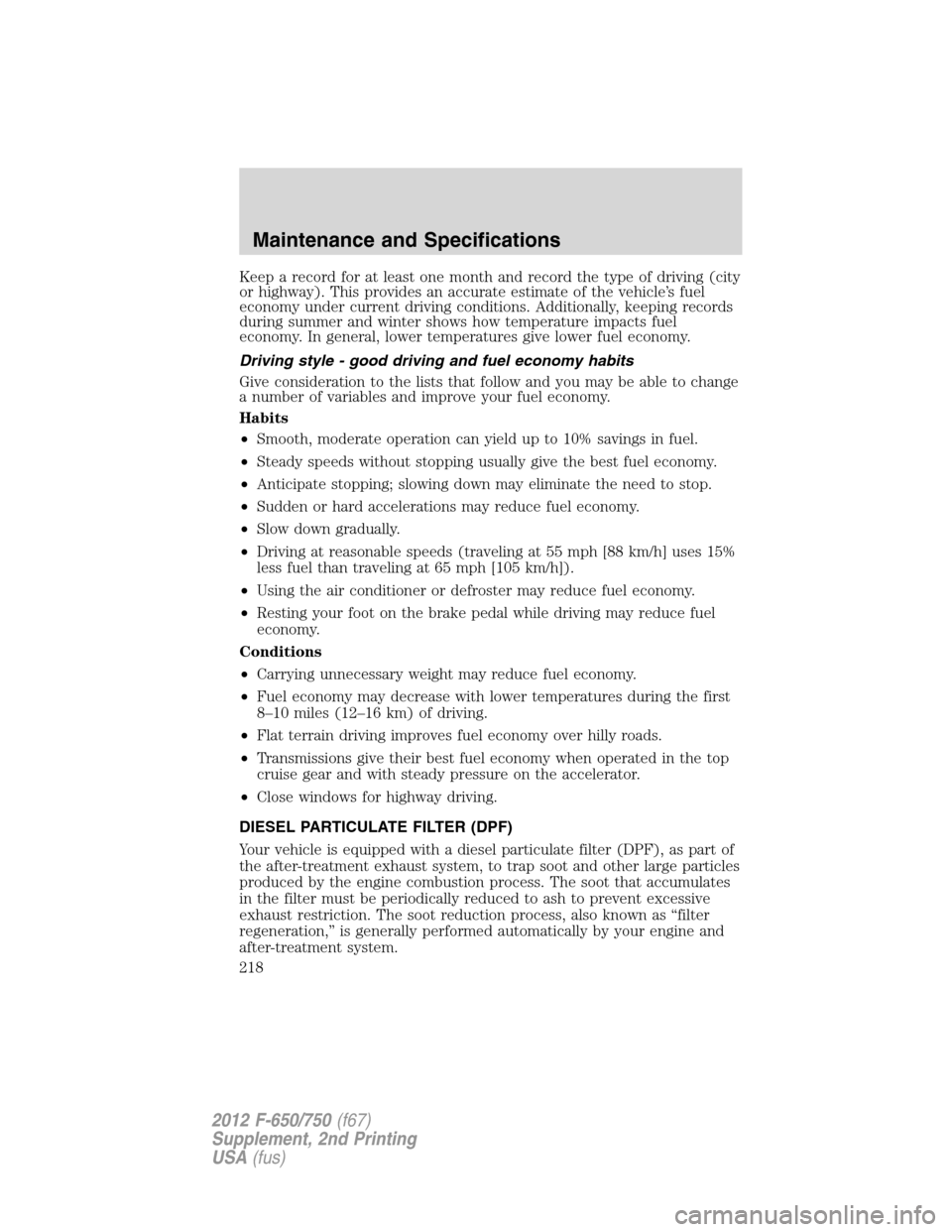
Keep a record for at least one month and record the type of driving (city
or highway). This provides an accurate estimate of the vehicle’s fuel
economy under current driving conditions. Additionally, keeping records
during summer and winter shows how temperature impacts fuel
economy. In general, lower temperatures give lower fuel economy.
Driving style - good driving and fuel economy habits
Give consideration to the lists that follow and you may be able to change
a number of variables and improve your fuel economy.
Habits
•Smooth, moderate operation can yield up to 10% savings in fuel.
•Steady speeds without stopping usually give the best fuel economy.
•Anticipate stopping; slowing down may eliminate the need to stop.
•Sudden or hard accelerations may reduce fuel economy.
•Slow down gradually.
•Driving at reasonable speeds (traveling at 55 mph [88 km/h] uses 15%
less fuel than traveling at 65 mph [105 km/h]).
•Using the air conditioner or defroster may reduce fuel economy.
•Resting your foot on the brake pedal while driving may reduce fuel
economy.
Conditions
•Carrying unnecessary weight may reduce fuel economy.
•Fuel economy may decrease with lower temperatures during the first
8–10 miles (12–16 km) of driving.
•Flat terrain driving improves fuel economy over hilly roads.
•Transmissions give their best fuel economy when operated in the top
cruise gear and with steady pressure on the accelerator.
•Close windows for highway driving.
DIESEL PARTICULATE FILTER (DPF)
Your vehicle is equipped with a diesel particulate filter (DPF), as part of
the after-treatment exhaust system, to trap soot and other large particles
produced by the engine combustion process. The soot that accumulates
in the filter must be periodically reduced to ash to prevent excessive
exhaust restriction. The soot reduction process, also known as “filter
regeneration,” is generally performed automatically by your engine and
after-treatment system.
Maintenance and Specifications
218
2012 F-650/750(f67)
Supplement, 2nd Printing
USA(fus)